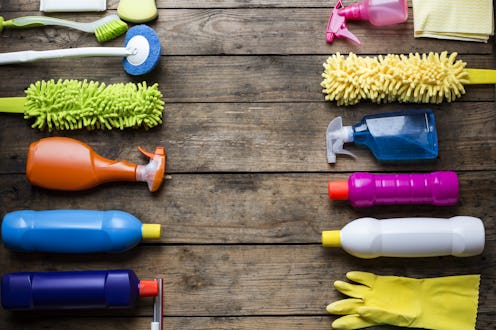With health a top priority at the moment, it seems everyone is trying to figure out how to make their homes a safe haven, free of viruses and the like. And while tidying up with a run-of-the-mill all-purpose cleaner or spray fit the bill once upon a time, the current health crisis is now calling for, well, more effort. In fact, knowing the difference between cleaning and disinfecting has never been more crucial — just ask any health professional.
Now, to be clear, “cleaning” entails removing dirt and germs off of spaces, according to the Centers For Disease Control And Prevention (CDC). "It does not kill germs, but by removing them, it lowers their numbers and the risk of spreading infection," says the organization's website. As for disinfecting, the CDC says this "refers to using chemicals, for example, EPA-registered disinfectants, to kill germs on surfaces." The site explains that this process may not necessarily clean dirty surfaces or remove germs, but by killing germs on a surface after cleaning, it can further lower the risk of spreading infection."
This means both cleaning and disinfecting are important to put into regular practice... together. “Disinfecting should follow cleaning, unless a surface doesn't seem visibly dirty, such as a remote control, in which case you can generally just disinfect straightaway,” explains Dr. Nidhi Ghildayal, PhD in Public Health and researcher for the University of Minnesota with a focus on infectious diseases.
Understanding the types of products that fall under the "cleaning" and "disinfecting" is also key here. “During current times, it is important to know the difference between items that clean, items that clean and disinfect some germs (such as vinegar and water solutions), and EPA (Environmental Protection Agency)-registered disinfectants that have been effectively proven to kill viruses similar to the coronavirus,” says Dr. Ghildayal in an emailed interview to The Zoe Report. “Ensure that you are using EPA-registered products after cleaning. Let solutions sit on the applicable surface for the required amount of time as per labels — with proper ventilation — to protect yourself from viruses.”
If you’re unclear on the approved products, technique, or setting time for proper disinfection, the EPA’s website has a thorough outline of its criteria to guide you. In general, however, “EPA-recommended disinfectants include hydrogen peroxide, isopropyl alcohol, and more,” says Dr. Ghildayal. Jagdish Khubchandani, MBBS, PHD, MPH, Professor of Health for Ball State University says disinfecting is where potent chemicals are necessary. "What pains me is that people are hoarding all types of disinfectants based on cost, smell, appeal, and availability," says Khubchandani. "Most household disinfectants can remove bacteria and some viruses, but not COVID-19. To kill COVID19, you need bleach, quaternary ammonium compounds, hydrogen peroxide, and rubbing alcohol (isopropyl alcohol or ethanol with a high concentration)."
The CDC recommends regularly cleaning and disinfecting "high-touch" surfaces in your home, such as tables, doorknobs, light switches, phones, tablets, remote controls, etc. "If surfaces are dirty, they should be cleaned using a detergent or soap and water prior to disinfection."
If you think you’re showing symptoms of coronavirus, which include fever, shortness of breath, and cough, call your doctor before going to get tested. If you’re anxious about the virus’s spread in your community, visit the CDC for up-to-date information and resources, or seek out mental health support.
